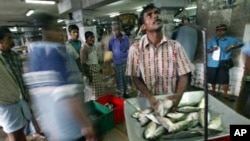The United States has long-standing ties with Sri Lanka. On a recent visit there, U.S. Assistant Secretary for South and Central Asian Affairs Robert Blake said the U.S. looks forward to helping Sri Lanka pursue a better future following the end of the 26-year civil war.
A strong economic partnership with the United States will be an important part of achieving that vision. Since Sri Lanka’s independence, the United States has worked through the U.S. Agency for International Development, or USAID, to provide over $2 billion in assistance, including in response to the devastating tsunami in December 2004 and to the on-going needs of internally displaced persons. USAID has established Public-Private alliances with Sri Lankan companies to expand operations into the North and East to create new opportunities for livelihoods.
The U.S. and Sri Lanka are also trading partners. The U.S. is the largest single export destination for Sri Lankan goods, with over 20 percent of its exports. The U.S. would like that relationship to grow and that’s why it is advocating for U.S. companies in Sri Lanka, where there are business opportunities ranging from tourism and infrastructure development to information technology.
But in the last three years, since the end of the civil conflict, few U.S. companies have come to invest in Sri Lanka, noted Assistant Secretary of State Blake. It’s not for lack of trying, but American investors, and investors from many other countries as well, face an uphill battle in Sri Lanka’s marketplace. The barriers include confusing and opaque rules on bidding for contracts, unpredictable government regulations, and corruption.
“The time is right now,” said Assistant Secretary Blake, “to think about how to help launch in Sri Lanka the type of large-scale economic growth that India experienced through market openings in the early 1990s.” With more aggressive reduction of tariff and non-tariff barriers, and liberalization of rules for foreign direct investment, the economy and bilateral trade with the U.S. can grow even more quickly.
The United States will do its part by continuing to advocate for trade and investment in Sri Lanka, in order to help build a more democratic, secure, and prosperous future for both countries. More broadly we continue to advocate for reconciliation between Sri Lanka’s multi-ethnic population, individual accountability for conflict-era abuses, and adherence to democratic principles that can help Sri Lanka reach its brighter future.
A strong economic partnership with the United States will be an important part of achieving that vision. Since Sri Lanka’s independence, the United States has worked through the U.S. Agency for International Development, or USAID, to provide over $2 billion in assistance, including in response to the devastating tsunami in December 2004 and to the on-going needs of internally displaced persons. USAID has established Public-Private alliances with Sri Lankan companies to expand operations into the North and East to create new opportunities for livelihoods.
The U.S. and Sri Lanka are also trading partners. The U.S. is the largest single export destination for Sri Lankan goods, with over 20 percent of its exports. The U.S. would like that relationship to grow and that’s why it is advocating for U.S. companies in Sri Lanka, where there are business opportunities ranging from tourism and infrastructure development to information technology.
But in the last three years, since the end of the civil conflict, few U.S. companies have come to invest in Sri Lanka, noted Assistant Secretary of State Blake. It’s not for lack of trying, but American investors, and investors from many other countries as well, face an uphill battle in Sri Lanka’s marketplace. The barriers include confusing and opaque rules on bidding for contracts, unpredictable government regulations, and corruption.
“The time is right now,” said Assistant Secretary Blake, “to think about how to help launch in Sri Lanka the type of large-scale economic growth that India experienced through market openings in the early 1990s.” With more aggressive reduction of tariff and non-tariff barriers, and liberalization of rules for foreign direct investment, the economy and bilateral trade with the U.S. can grow even more quickly.
The United States will do its part by continuing to advocate for trade and investment in Sri Lanka, in order to help build a more democratic, secure, and prosperous future for both countries. More broadly we continue to advocate for reconciliation between Sri Lanka’s multi-ethnic population, individual accountability for conflict-era abuses, and adherence to democratic principles that can help Sri Lanka reach its brighter future.

















